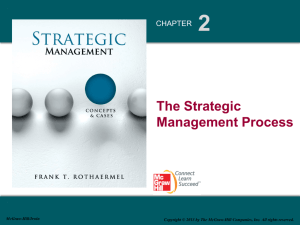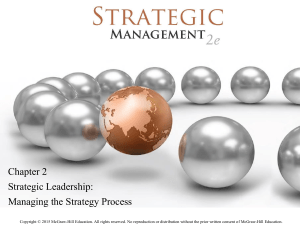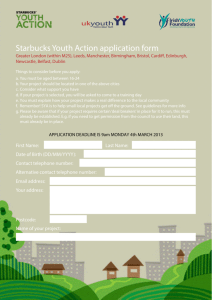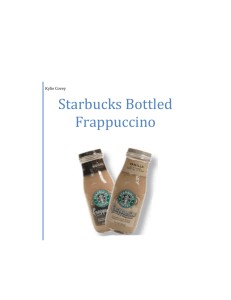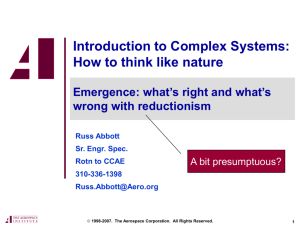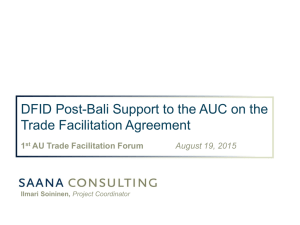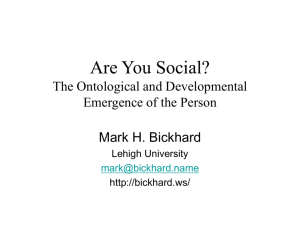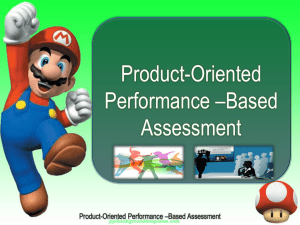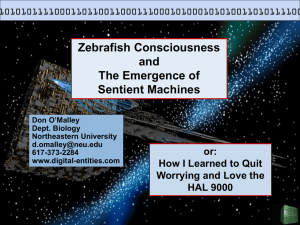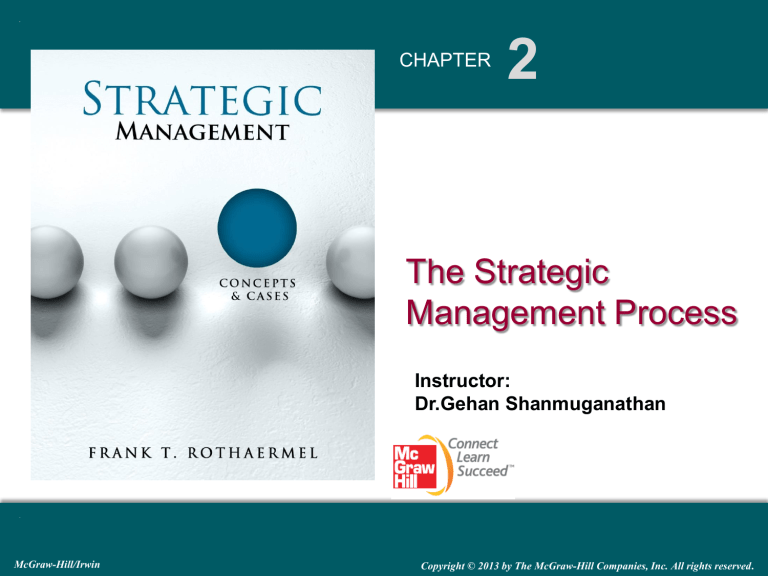
CHAPTER
2
The Strategic
Management Process
Instructor:
Dr.Gehan Shanmuganathan
McGraw-Hill/Irwin
Copyright © 2013 by The McGraw-Hill Companies, Inc. All rights reserved.
LO 2-1 Explain the role of vision, mission, and values in the strategic
management process.
LO 2-2 Describe and evaluate the role of strategic intent in achieving
long-term goals.
LO 2-3 Distinguish between customer-oriented and product-oriented
missions and identify strategic implications.
LO 2-4 Critically evaluate the relationship between mission statements and
competitive advantage.
LO 2-5 Explain why anchoring a firm in ethical values is essential for longterm success.
LO 2-6 Compare and contrast strategic planning, scenario planning, and
strategy as planned emergence, and discuss strategic implications.
2-2
ChapterCase 2
Teach For America: Inspiring Future Leaders
• TFA Mission: Eliminate educational inequality
Started by an undergraduate student
Inspiring mission
Provide a meaningful service option for bright young people
• Make teaching to the neediest high prestige
Over 40,000 applicants for 4,500 jobs
TFA Video
2-3
VISION, MISSION, AND VALUES
• What are visionary organizations?
Begin with the end in mind
Similar to designing & building a home
Vision – what to ultimately accomplish?
Mission – what is the firm about?
Values – how to accomplish goals?
2-4
VISION, MISSION, AND VALUES
• What is forming strategic intent?
Staking out a desired leadership position in the long
term that far exceeds a company's current situation
Often used in Japanese corporate settings
Canon will "beat Xerox"
Effective use of stretch goals
Competitive advantage for tomorrow
2-5
VISION, MISSION, AND VALUES
• CUSTOMER-ORIENTED MISSIONS
• Define the firm in terms of solutions for customers
Disney: "Make People Happy"
Enhanced strategic flexibility
NOT the same as listening to customers
• PRODUCT-ORIENTED MISSIONS
• Define the firm in terms of products or services
U.S. Railroads: "Safest… N. American railroad”
Missed the chance to move into delivery before
UPS & Federal Express
2-6
MISSION STATEMENTS AND
COMPETITIVE ADVANTAGE
• Do mission statements help gain & sustain
competitive advantage?
Results are inconclusive
Need strategic commitments to succeed
• Positive associations – Visionary firms
• Negative associations – Better World Books
• No associations – Intel
2-7
Living the Values
• Ethical standards and norms that govern
behavior.
How do we accomplish our goals?
• McKesson – ICARE
Shared principles a framework for daily interactions
• Dark side of values
Bernard Madoff
Ponzi scheme estimated at $65 billion in fraud
Enron
One of the largest bankruptcies in U.S. history
Over 50,000 jobs lost (Enron & Arthur Anderson)
2-8
The Strategic Management Process
1. Strategic Planning
2. Scenario Planning
3. Strategy as Planned Emergence
2-9
Strategy as Strategic Planning
• Top-down rational planning
Define mission, vision, & goal (strategic intent)
External analysis of opportunities and threats
Internal analysis of strengths and weaknesses
Create strategic fit through SWOT
Formulate appropriate strategy
Implement chosen strategy
Monitor performance & modify if necessary
2-10
Strategy as Scenario Planning
• Scenario planning
Envision different "what-if" plans
Generates a dominant plan
Must implement the most probable option
Keeps other scenarios in the event of changes…
"Arab Spring" impact on the oil industry?
Good example of the AFI framework
2-11
Strategy as Planned Emergence
• Strategic Initiative
Google 50% from the "20% rule"
Enron wind investment…
• Mintzberg Planned Emergence
• Strategy can come from top or bottom
Some intended strategies drop off in the process
Allows for new emerging ideas to become realized
Resource allocation process (RAP)
Serendipity can have dramatic effects
2-12
Bottom-up Strategic Initiatives /
Autonomous Actions
• Microsoft
Internet Explorer
Xbox
• Intel
DRAM exit and entry into semiconductors
• Starbucks
Frappuccino
• Google
50% of new products come from 20% autonomous
time
2-13
STRATEGY HIGHLIGHT 2.3
”It’s Not What We Do!”
• Starbucks
Autonomous action of mid-level manager
Tenacity and persistence of a store manager
Risk of failure
Possible career-limiting action
Organization must be willing to accept new ideas
Frappuccino was born!
Contributing 20% of revenues for Starbucks recently
2-14
CHAPTERCASE 2 /Consider This…
• Teach For America is TWENTY years old!
• A $200 million dollar organization
Teacher effectiveness improves with…
Student–oriented achievement course objectives
• What role did TFA’s vision statement have?
• How have they recruited so many into teaching?
• Could it have worked as a for-profit firm?
2-15

